science

Differences in our perception of physical beauty have an enormous impact on the fashion, cosmetics, and weight control industries, and more recently on aesthetic surgery trends. Understanding how culture and region alter the perception of beauty is therefore not only of anthropological and social interest but underpins multibillion dollar industries across the globe.
According to Anil Mathur of Hofstra University in New York and colleagues there and at the City University of New York, marketers can hope to expand their reach into overseas markets but they cannot build brand equity if they lack regional knowledge and an understanding of consumer characteristics and preferences across cultures.
Mathur and colleagues have now tested a physical vanity scale across China, India and USA and have established that the scale could be used across culturally diverse countries. (…)
The team found that while the details concerning beauty perception may differ, their data supports the notion that physical vanity is a universal construct that applies across cultures.
{ EurekAlert | Continue reading }
artwork { Modigliani, Seated Nude, 1916 }
economics, psychology | October 18th, 2010 11:26 am

In new research published in Psychological Science, scientists analyzed genes in the dopamine system and found a group of mutations that help predict whether someone is inclined toward sensation seeking.
Jaime Derringer and coauthors wanted to use a new technique to find out more about the genetics of sensation seeking. Most obvious connections with genes have already been found, Derringer says. Now new methods are letting scientists look for more subtle associations between genes and all kinds of traits, including behavior and personality.
{ APS | Continue reading }
genes, psychology | October 13th, 2010 8:05 pm

Researcher Soraya Mehdizadeh (2010) proposes that sites like Facebook and MySpace have contributed to the rise of narcissistic tendencies. (…)
She defines narcissists as individuals who seek superficial relationships with high status individuals who can contribute to public glory (2010: 358). Online social networking sites encourage these sorts of relationships:
First, this setting offers a gateway for hundreds of shallow relationships (i.e., virtual friends), and emotionally detached communication (i.e., wall posts, comments). While these sites do indeed serve a communicative purpose among friends, colleagues, and family, other registered users can initiate requests to be friends, and one’s social network often snowballs rapidly across institutions in this fashion.
One way this sort of relationship is achieved is through the presentation of an attractive self—the user must reveal something that encourages the connection.
This connection may be emotionally appealing (e.g., a shared history: attending the same high school or college) or physically appealing (e.g., an enticing photo, a pleasant demeanor).
The latter seems particularly important once the user moves past first tier connections and begins to add connections from the second tier (i.e., friend of a friend) and beyond. According to Mehdizadeh, this opens the door for a showing of the “hoped for possible self,” which “emphasizes realistic socially desirable identities an individual would like to establish given the right circumstances.”
{ Anthropology in Practice | Continue reading }
photo { Milos Gazdic }
relationships, science, social networks | October 13th, 2010 8:00 pm

A neurologist and other scientists argue animals are capable of having spiritual experiences.
The researchers hold that spiritual experiences originate within primitive parts of the human brain, structures shared by animals.
The challenge lies in proving what animals experience. (…)
A Neurology journal study, for example, determined that out-of-body experiences in humans are likely caused by the brain’s arousal system, which regulates different states of consciousness.
“In humans, we know that if we disrupt the (brain) region where vision, sense of motion, orientation in the Earth’s gravitational field, and knowing the position of our body all come together, then out-of-body experiences can be caused literally by the flip of a switch,” he said. “There is absolutely no reason to believe it is any different for a dog, cat, or primate’s brain.”
Other mammals also probably have near-death experiences comparable to those reported by certain humans, he believes.
{ Discovery | Continue reading }
animals, science | October 12th, 2010 9:59 pm

The brain has long enjoyed a privileged status as psychology’s favorite body organ. This is, of course, unsurprising given that the brain instantiates virtually all mental operations, from understanding language, to learning that fire is dangerous, to recalling names, to categorizing fruits and vegetables, to predicting the future. Arguing for the importance of the brain in psychology is like arguing for the importance of money in economics.
More surprising, however, is the role of the entire body in psychology and the capacity for body parts inside and out to influence and regulate the most intimate operations of emotional and social life. The stomach’s gastric activity , for example, corresponds to how intensely people experience feelings such as happiness and disgust. The hands’ manipulation of objects that vary in temperature and texture influences judgments of how “warm” or “rough” people are. And the ovaries and testes’ production of progesterone and testosterone shapes behavior ranging from financial risk-taking to shopping preferences.
Psychology’s recognition of the body’s influence on the mind coincides with a recent focus on the role of the heart in our social psychology. It turns out that the heart is not only critical for survival, but also for how people related to one another.
{ Scientific American | Continue reading }
One of the pressing questions in seventeenth century philosophy, and perhaps the most celebrated legacy of Descartes’s dualism, is the problem of how two radically different substances such as mind and body enter into a union in a human being and cause effects in each other. How can the extended body causally engage the unextended mind, which is incapable of contact or motion, and “move” it, that is, cause mental effects such as pains, sensations and perceptions.
Spinoza, in effect, denies that the human being is a union of two substances. The human mind and the human body are two different expressions—under Thought and under Extension—of one and the same thing: the person. And because there is no causal interaction between the mind and the body, the so-called mind-body problem does not, technically speaking, arise.
{ Stanford Encyclopedia of Philosophy | Continue reading }
photo { Philippe Halsman }
ideas, science, spinoza | October 12th, 2010 9:37 pm
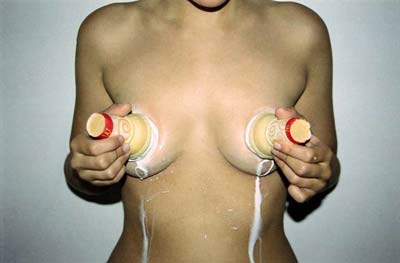
Researchers say women really do sweat far less than men, particularly during intensive exercise.
On average, they tend to perspire half as much after similar amounts of physical activity in the same temperatures.
Sweating is an essential bodily function which cools us down. As we release fluid through our skin it evaporates, and this process takes heat from the body, lowering our overall temperature.
Scientists believe that thousands of years ago men evolved to sweat more than women as they tended to be more active.
They needed to cool down quickly while hunting wild animals in sweltering heat, for example.
By contrast, women evolved to sweat less, the experts believe. Their smaller bodies contain less water than men’s so if they perspire too much, there is a danger they will become dehydrated.
The Japanese researchers warn that women may be more at risk from heat stroke as their bodies are not as good at naturally cooling themselves down.
But the scientists also discovered that very fit people sweat the most, regardless of sex. Someone who plays a lot of sport will give off 60 per cent more bodily fluid during exercise than someone of the same sex who is relatively inactive.
{ DailyMail | Continue reading }
photo { Stephanie Gonot }
health, science | October 12th, 2010 9:23 pm
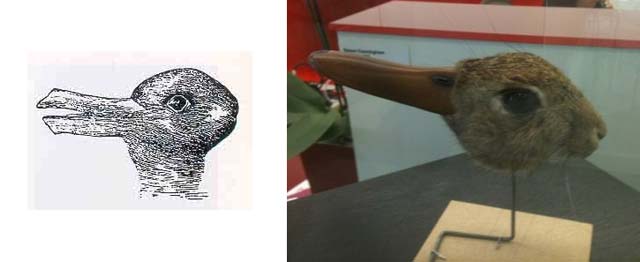
{ 1. Joseph Jastrow’s Duck-Rabbit, 1899, based on drawing published in German humor magazine Fliegende Blatter, 1892 | 2. Taxidermed rabbit–duck | via Richard Wiseman }
I noticed a depiction of the famous “duck-rabbit” figure, described as an “illusion” and attributed to Wittgenstein (Malach, Levy, & Hasson, 2002).
Technically, the duck-rabbit figure is an ambiguous (or reversible, or bistable) figure, not an illusion (Peterson, Kihlstrom, Rose, & Glisky, 1992). The two classes of perceptual phenomena have quite different theoretical implications. From a constructivist point of view, many illusions illustrate the role of unconscious inferences in perception, while the ambiguous figures illustrate the role of expectations, world-knowledge, and the direction of attention (Long & Toppino, 2004).
For example, children tested on Easter Sunday are more likely to see the figure as a rabbit; if tested on a Sunday in October, they tend to see it as a duck or similar bird (Brugger & Brugger, 1993).
But the more important point of this letter concerns attribution: the duck-rabbit was “originally noted” not by Wittgenstein, but rather by the American psychologist Joseph Jastrow in 1899.
{ John F. Kihlstrom, | Continue reading }
Linguistics, animals, ideas, psychology, taxidermy, visual design | October 12th, 2010 6:22 pm

MEDICINE PRIZE: Simon Rietveld of the University of Amsterdam, The Netherlands, and Ilja van Beest of Tilburg University, The Netherlands, for discovering that symptoms of asthma can be treated with a roller-coaster ride.
CHEMISTRY PRIZE
Eric Adams of MIT, Scott Socolofsky of Texas A&M University, Stephen Masutani of the University of Hawaii, and BP [British Petroleum], for disproving the old belief that oil and water don’t mix.
PHYSICS PRIZE: Lianne Parkin, Sheila Williams, and Patricia Priest of the University of Otago, New Zealand, for demonstrating that, on icy footpaths in wintertime, people slip and fall less often if they wear socks on the outside of their shoes.
MANAGEMENT PRIZE
Alessandro Pluchino, Andrea Rapisarda, and Cesare Garofalo of the University of Catania, Italy, for demonstrating mathematically that organizations would become more efficient if they promoted people at random.
PUBLIC HEALTH PRIZE
Manuel Barbeito, Charles Mathews, and Larry Taylor of the Industrial Health and Safety Office, Fort Detrick, Maryland, USA, for determining by experiment that microbes cling to bearded scientists.
{ The 2010 Ig Nobel Prize Winners | Continue reading }
science | October 11th, 2010 7:33 pm

New research indicates that holding a pose that opens up a person’s body and takes up space will alter hormone levels and make the person feel more powerful and more willing to take risks.
“These poses actually make you more powerful,” said study researcher Amy C.J. Cuddy, a social psychologist at the Harvard Business School.
The opposite also proved true: Constrictive postures lowered a person’s sense of power and willingness to take risks. (…)
The basic idea is that the mind/body relationship is not a one-way street, with the mind giving orders for the body to carry out. Rather, the body also influences the mind. Other studies have indicated, for example, that holding an expression, like a smile, can alter one’s mood, as can a hunched posture.
{ LiveScience | Continue reading }
photo { Francesca Woodman, Self-portrait, 1975-78 }
relationships, science | October 11th, 2010 7:20 pm

In his three volume work Obliscence, Theories of Forgetting and the Problem of Matter, Geoffrey Sonnabend departed from all previous memory research with the premise that memory is an illusion. Forgetting, he believed, not remembering is the inevitable outcome of all experience. From this perspective,
We, amnesiacs all, condemned to live in an eternally fleeting present, have created the most elaborate of human constructions, memory, to buffer ourselves against the intolerable knowledge of the irreversible passage of time and the irretrieveability of its moments and events.
Sonnabend believed that long term or “distant” memory was illusion, but similarly he questioned short term or “immediate” memory. On a number of occasions Sonnabend wrote, “there is only experience and its decay” by which he meant to suggest that what we typically call short term memory is, in fact, our experiencing the decay of an experience. Interestingly, however, Sonnabend employed the term true memory, to describe this process of decay which, he held, was, in actuality, not memory at all.
Sonnabend believed that this phenomenon of true memory was our only connection to the past, if only the immediate past, and, as a result, he became obsessed with understanding the mechanisms of true memory by which experience decays. In an effort to illustrate his understanding of this process, Sonnabend, over the next several years, constructed an elaborate Model of Obliscence (or model of forgetting) which, in its simplest form, can be seen as the intersection of a plane and cone.
{ Lawrence Weschler, Mr. Wilson’s Cabinet Of Wonder | Google Books | Continue reading | Amazon }
painting { left: Linnea Strid }
brain, flashback, ideas | October 8th, 2010 7:17 pm

Researchers at the University of California, Berkeley, are challenging long-held beliefs that human beings are wired to be selfish. In a wide range of studies, social scientists are amassing a growing body of evidence to show we are evolving to become more compassionate and collaborative in our quest to survive and thrive.
In contrast to “every man for himself” interpretations of Charles Darwin’s theory of evolution by natural selection, Dacher Keltner, a UC Berkeley psychologist and author of “Born to be Good: The Science of a Meaningful Life,” and his fellow social scientists are building the case that humans are successful as a species precisely because of our nurturing, altruistic and compassionate traits.
They call it “survival of the kindest.”
{ UC Berkeley | Continue reading }
photo { Daido Moriyama }
ideas, science | October 8th, 2010 3:34 pm
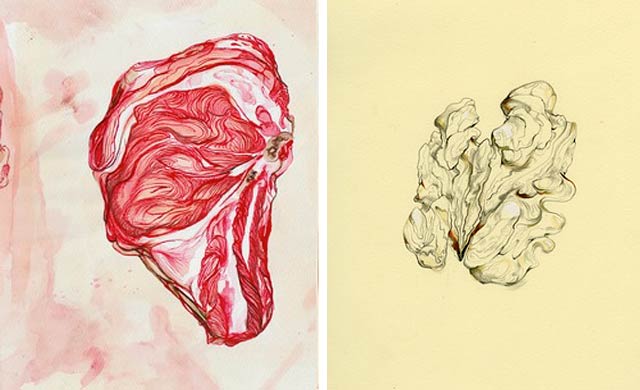
Losing weight can be described at its simplest as a matter of counting calories during the daytime. Consume fewer calories and burn more through activity and exercise, and you’re likely to lose weight. Eat more high-calorie foods and sit on the couch all day watching football, and you get the opposite effect. But according to a new study from University of Chicago Medical Center researchers, another number should be taken into account by dieters: hours of sleep. (…)
“If your goal is to lose fat, skipping sleep is like poking sticks in your bicycle wheels,” Penev said. “Cutting back on sleep, a behavior that is ubiquitous in modern society, appears to compromise efforts to lose fat through dieting. In our study it reduced fat loss by 55 percent.”
{ University of Chicago Medical Center | Continue reading }
artwork { Left: Robert Blake | Right: Katie Rhody | Nosh: Food Art Show curated by Kady Grant and Anthony Iacono, Opening Friday, October 8th, 7-10pm | Culture Fix, NYC }
food, drinks, restaurants, health, science, sleep, visual design | October 8th, 2010 3:29 pm

Couples develop their own language of love that ebbs and flows depending on the state of their relationship, scientists believe. (…)
The study suggests style matching has the potential to quickly and easily reveal whether any given pair of people — ranging from business rivals to romantic partners — are psychologically on the same page and what this means for their future together. (…)
The researchers extended their work by analysing friendships such as that between Sigmund Freud and Carl Jung who wrote to each other almost weekly over a seven-year period as their careers were developing.
Using style-matching statistics, the authors were able to chart the two men’s tempestuous relationship from their early days of joint admiration to their final days of mutual contempt.
{ Telegraph | Continue reading }
photo { Lee Friedlander }
ideas, psychology, relationships | October 5th, 2010 2:39 pm

According to the research, over 95% of males have masturbated to orgasm by age 20, compared to around 60% of women (with some studies suggesting an even larger gap).
The discrepancy with regard to masturbation is doubly problematic because masturbation, it turns out, is a particularly important predictor of sexual health and happiness for women, more so then for men. One of the best predictors of whether a woman will be able to achieve orgasm in her sexual relations is a history of masturbation in adolescence.
Why such a gap? One reason may be men’s higher sex drive. If you define sex drive as preoccupation with sexual behavior and thoughts, including sex crimes and paraphilias, then men routinely manifest higher levels of it than women. Such elevated interest may lead to higher masturbation rates. Structural differences may also play a role. A penis is highly accessible and regularly handled in the act of urination, which may lead to greater familiarity with its potential uses. (…)
According to Thomas W. Laqueur, a professor of history at the University of California at Berkeley, masturbation was not a topic of great interest to the powers that be until 1712, when a con man named John Marten anonymously published a book spectacularly entitled: Onania; or, The Heinous Sin of Self Pollution and all its Frightful Consequences, in both sexes Considered…
{ PsychologyToday | Continue reading }
photo { Nobuyoshi Araki }
psychology, relationships, science, sex-oriented | October 5th, 2010 2:33 pm

Psychologists have long argued that people have a “set point” for happiness. Regardless of what life brings, the set-point theory goes, happiness levels tend to be stable. A big life event could create a boost of joy or a crush of sorrow, but within a few years, people return to a predetermined level of life satisfaction, according to the theory.
A new study, which used a nationally representative sample of almost 150,000 German adults, finds the opposite. (…) The study also echoed previous happiness research in finding that money doesn’t buy happiness. (…)
So what contributed to long-term happiness? The researchers found several correlations between life choices and life satisfaction:
• Marry well
• Focus on the family
• Go to church
• Work, but not too much (or too little)
• Social interaction and exercise
{ LiveScience | Continue reading }
psychology | October 5th, 2010 2:00 pm

Some people meet, fall in love and get married right away. Others can spend hours in the sock aisle at the department store, weighing the pros and cons of buying a pair of wool argyles instead of cotton striped. (…)
People who often have conflicting feelings about situations—the shades-of-gray thinkers—have more of what psychologists call ambivalence, while those who tend toward unequivocal views have less ambivalence. (…)
For decades psychologists largely ignored ambivalence because they didn’t think it was meaningful. Now, they have been investigating how ambivalence, or lack of it, affects people’s lives, and how they might be able to make better decisions. Overall, thinking in shades of gray is a sign of maturity, enabling people to see the world as it really is. (…)
If there isn’t an easy answer, ambivalent people, more than black-and-white thinkers, are likely to procrastinate and avoid making a choice, for instance about whether to take a new job, says Dr. Harreveld. But if after careful consideration an individual still can’t decide, one’s gut reaction may be the way to go.
{ WSJ | Continue reading | Thanks Tim }
psychology | October 5th, 2010 9:41 am

Mathematical proofs feel both beautiful and inevitable. Once you understand a proof of, say, the Pythagorean theorem, you can be sure this knowledge won’t be contradicted by any future discovery nor changed by any new insight. So you can use your knowledge to measure distances or map people’s Netflix tastes with utter confidence. Unsurprisingly, as I heard the cosmologist Mario Livio say recently, “most working mathematicians are Platonists”—convinced their proofs and concepts exist independently of the human race, eternally out there, waiting to be discovered.
Biology isn’t like this. Evolution is accepted as the fundamental theory of life because we see evidence of it all around us. Not because it has been irrefutably, mathematically proved.
Gregory Chaitin: “it is scandalous that we do not have a mathematical proof that evolution works.” Hence one of his ongoing intellectual quests, described engagingly in this talk: The development of “metabiology.” Metabiology is to be a model of life that will let researchers “represent mathematically the fundamental biological principles of evolution in such a manner that we can prove that evolution must take place.”
{ Big Think | Continue reading }
science, theory | October 5th, 2010 9:40 am
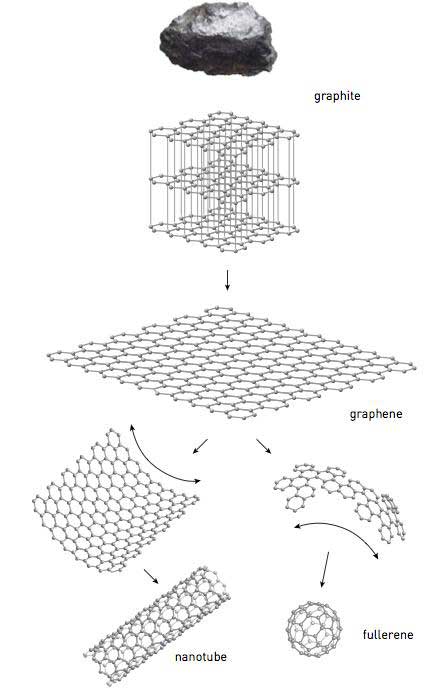
{ The Royal Swedish Academy of Sciences has awarded the Nobel Prize in Physics for 2010 to Andre Geim and Konstantin Novoselov, both of the University of Manchester, “for groundbreaking experiments regarding the two-dimensional material graphene.” | ScienceDaily | full story }
science | October 5th, 2010 9:05 am

Grunting During a Tennis Shot May Provide a Competitive Advantage
Some tennis fans and players feel that grunting during a tennis shot distracts the opponent, and therefore provides an unfair competitive advantage. Many professional tennis players grunt; one of them (Maria Sharapova) is reported to grunt at over 100 decibels. (…)
Grunting slowed down student response time by between 21 and 33 milliseconds, and the students made between 3% and 4% more predicted directional errors, whether the video clips ended at contact with the ball or 100 milliseconds afterwards. These differences in time and error were statistically significant.
{ NASW | Continue reading }
psychology, sport | October 3rd, 2010 11:37 am
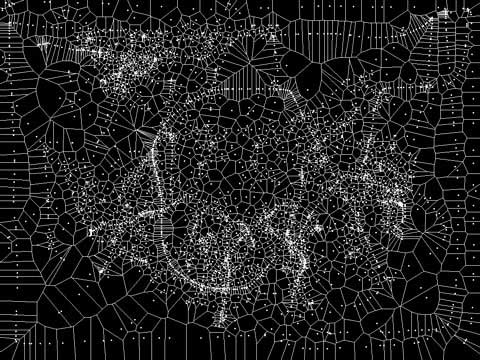
{ It might be a place that only a lichen or pond scum could love, but astronomers said Wednesday that they had found a very distant planet capable of harboring water on its surface, thus potentially making it a home for plant or animal life. Nobody from Earth will be visiting anytime soon: The planet, which goes by the bumpy name of Gliese 581g, is orbiting a star about 20 light-years away in the constellation Libra. | NY Times | full story }
mystery and paranormal, science, space | October 3rd, 2010 11:05 am






















